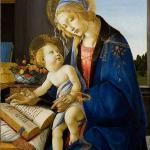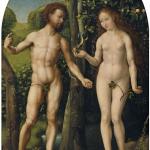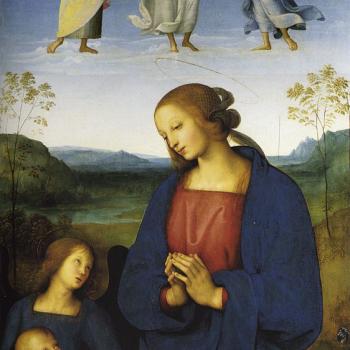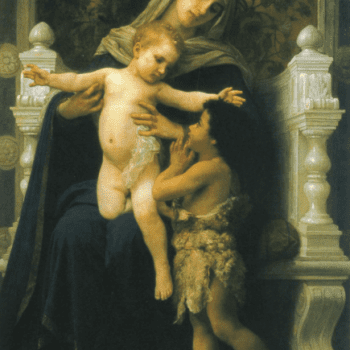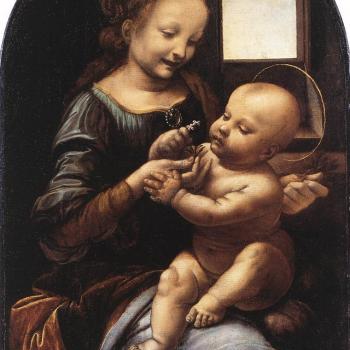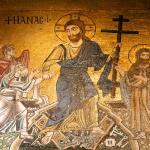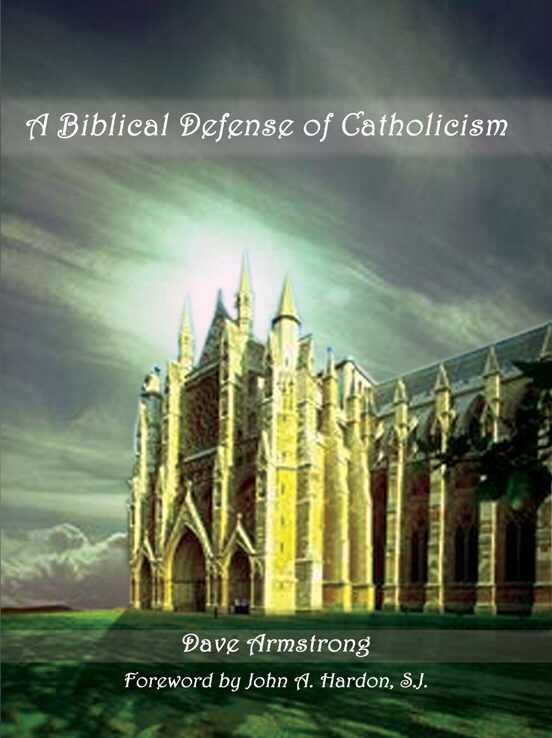
From the 750-page first draft version of my first book, A Biblical Defense of Catholicism (1994). Protestant quotations will be in blue; Orthodox in green.
*****
I. Introduction
Dom Ralph Russell
“Distinguished Anglican scholars (Hoskyns, Lightfoot), besides . . . Roman Catholics, suggest that in a text to which St. John attaches such importance on Calvary more is involved than simply asking the disciple to look after his mother. For one thing, it is his mother whom he addresses first. Then in Genesis 3:20 we find `Adam called the name of his wife (same word as `woman’) Eve, because she was the mother of all the living’ . . . The beloved disciple is real, but like other figures in the Gospel (e.g., Nicodemus), he is also representative. For all the disciples are beloved, as are all who keep Jesus’s commandments (14:21). Is there, then, here a scriptural basis for understanding that Jesus gives them to Mary as sons and Mary to them as their Mother? It is certainly worth investigating . . .” (in Alberic Stacpoole, editor, Mary’s Place in Christian Dialogue, Wilton, Connecticut: Morehouse-Barlow, 1982, 49)
Gordon Wakefield
“Mary is ever woman. The New Testament does not record her as divine. She stands with sinners beneath the cross as the representative not of the kingdom of God but of the Church on earth. The words of Christ in the Johannine passion, `Woman behold thy son’, legitimately allow us to think of Mary as the Mother of the Christian family, the Church.” (Ibid., 157)
Mary in the New Testament
“At the foot of the cross Jesus gives his physical mother a spiritual role as mother of the disciple par excellence, and the disciple a role as her son. Thus there emerges a familial relationship in terms of discipleship . . .
“A . . . variant of this approach (and one with much older attestation, beginning with Origen) is to treat the mother of Jesus as a general symbol for the church, so that Jesus is leaving the church to the Christians as their mother . . .
“Mary, . . . becomes herself a model of belief and discipleship . . . Most of us did not exclude, but were very hesitant about accepting, a further, secondary symbolism for Mary, whether as the Israel which brings forth Jewish Christianity, Lady Zion, or the new Eve . . . We did see in John’s own symbolic treatment of Jesus’ mother an opening made for the process of further Marian symbolizing within the church.” (Raymond E. Brown et al, Mary in the New Testament: A Collaborative Assessment by Protestant and Roman Catholic Scholars, Philadelphia: Fortress Press, 1978, 213, 216, 288-289)
Max Thurian
“Jesus addresses His mother in order to commit the disciple to her and only secondly speaks to him in order to commit His mother to his care. If this were only an act of filial love, the first word should surely be addressed to the disciple . . . If Jesus begins with Mary, in order to designate the disciple as her son, it is because this word has more than a purely private interpretation; it has another import . . .
“How, in such an important and solemn context, can the episode of the disciple and Mary alone be accepted as having simply a domestic and private interpretation? . . .
“Mary, called `Woman’ by the Crucified, and then given as `Mother’ to the `disciple,’ is, at the foot of the Cross, the figure of the Church, the consoling Mother of the faithful . . .
“In the Gospel of St. John, neither `the mother’ nor `the disciple’ bear their proper names of Mary and John; they are described by their vocations, . . . they are `types,’ `icons’ of Mother Church and of the faithful brethren of Jesus . . .
“The double phrase used by the Crucified: `Woman, behold thy son; behold thy mother’ recalls the covenant formula of the Old Testament: `I will be to him a Father and he will be to me a son’ (2 Sam 7:14) . . .
“The New Covenant was established between the Father and the beloved disciples, Christ’s brethren, by the motherhood of the Church, the `Jerusalem from on high which is free, our mother’ (Gal 4:26). The Church, symbolized by Mary, receives at the foot of the Cross this maternal mission . . .
“We understand the motherhood of the Church as we meditate on the motherhood of Mary, the mother of the Lord and the mother of the blessed disciple.” (Mary: Mother of all Christians, translated by Neville B. Cryer, New York: Herder & Herder, 1963 [orig. 1962], 150-151, 160, 162-166)
II. Revelation 12:1, 5, 17
And there appeared a great wonder in heaven; a woman clothed with the sun, and the moon under her feet, and upon her head a crown of twelve stars . . .
And she brought forth a man child, who was to rule all nations with a rod of iron: and her child was caught up unto God, and to his throne . . .
And the dragon was wroth with the woman, and went to make war with the remnant of her seed, which keep the commandments of God, and have the testimony of Jesus Christ.
Mary in the New Testament
“Revelation 12 . . . seems to employ the symbolism of a woman described like Israel who is the mother of the messiah and the mother of Christian disciples . . .
“Related to this is the possibility of Mary/Eve symbolism in John 19:25-27 . . . especially since the woman in Revelation 12 is in conflict with a dragon who in 12:9 is specifically identified with the ancient serpent of the Genesis story. According to Gen 3:15 there would be enmity between the serpent and the `woman,’ between the serpent’s seed (offspring) and the woman’s seed (offspring). If the mother of Jesus whom he addresses as `Woman’ has an Eve symbolism, this would be the moment when she would become a mother with seed (offspring), the Christian disciple; and then in the language of Rev 12:17 there would be war between the dragon/serpent on the one side and the woman and her offspring on the other . . .
“We recognized that some major scholars do see in 19:25-27 [of John] one or other of these supplementary symbolisms, and also that it is very difficult to be certain of the limits of Johannine symbolism. In the early post-New Testament period a great deal of symbolism did attach itself to Mary, including some of the symbols we have discussed, e.g., the church, or Eve . . .
“Granted that the woman described in Revelation 12 refers primarily to the people of God, Israel and the Church, is there a possibility of a secondary reference to Mary? The plasticity of apocalyptic symbolism makes a double reference for the one symbol a possibility, and the biblical conception of corporate personality makes it possible for an individual to represent a collectivity. The main argument for a reference to Mary is that the narrative refers to the woman as the mother of the Messiah . . .
“In the Fourth Gospel . . . through the death scene she becomes the mother of the beloved disciple . . . This motif also occurs in Revelation 12, for there the woman is the mother of other offspring who are Christian believers (12:17) . . . The Anglican scholar A. Richardson (Introduction to the Theology of the N.T. [New York: Harper & Row, 1958], 176) thought that Rev 12:17 might imply a double symbolism in which the woman represented both the Jewish Church and Eve/Mary.” (Brown et al, ibid., 217-218, 235, 238)
Max Thurian
“There can be no doubt that this vision of the Woman in conflict with the Dragon reminds us of . . . the `Protoevangel’ (Gen 3:15).” (Thurian, ibid., 177)
Dom Ralph Russell
“In early centuries she was thought to be simply the Church, but it is increasingly recognized that John’s symbols are polyvalent and that Mary can hardly be out of mind. She bears in pain (cf. Gen 3:16 – anticipation of Calvary?) a male child, . . . (this is certainly the Messiah, Ps 2:9) . . . Eventually the dragon goes off to `make war on the rest of her seed . . . (i.e., the Christians). Have we here scriptural elements for the relationship between Mary and the Church developed by the fathers and the Second Vatican Council, and, although the Council does not use it, is there a hint of the assumption?” (Stacpoole, ibid., 49)
John Henry Cardinal Newman
“What I would maintain is this, that the Holy Apostle would not have spoken of the Church under this particular image, unless there had existed a blessed Virgin Mary, who was exalted on high and the object of veneration to all the faithful. No one doubts that the `man-child’ spoken of is an allusion to our Lord; why then is not `the Woman’ an allusion to his mother?” (“Letter to Pusey”, Difficulties of Anglicans, vol. 2, 1875)
III. Mary as Intercessor
As the preeminent saint and “all-holy one”, Mary has a singular role in heaven as an intercessor for us, and, as such, is venerated due to her unique attributes and privileges. These aspects have been dealt with elsewhere in this work, but we shall, for good measure, also cite three writers presently:
John McHugh
“God wills us to be saved, and to work out our salvation, as members of one body, the Church . . . Praying for one another in this life is normal for Christians. Deep in the Catholic consciousness is the conviction that the faithful departed do not cease from prayer, least of all when they stand before the throne of God. And here Mary is in a privileged position. And though a person deeply conscious of his own weakness may find it psychologically difficult to identify with Christ in glory, because he is God, he may find it psychologically easy to ask Mary to intercede on his behalf because she as a creature is on his side of the divide between God and his creatures.” (Stacpoole, ibid., 54-55)
Kallistos Ware
“The Church is a single family, including both the living and the dead. It is an all-embracing unity in Christ, a unity expressed and realized above all through prayer . . .
“And among all the faithful departed for whose prayers we ask, to whom should we turn more frequently and more fervently than to the Holy Virgin? If she is a model of what it means to belong to the Church, then she must be, among other things, a model of intercessory prayer . . .
“It is misleading to speak, in this context, of praying `to’ Mary. We pray only to God, whereas we `invoke’ or `call upon’ His Mother: we do not pray to her, but we ask for her prayers – an important distinction. And we are firmly convinced that these requests for her intercession, so far from diminishing our devotion to Christ, serve rather to enrich it.” (Stacpoole, ibid., 174-175)
John Henry Cardinal Newman
“I consider it impossible then, for those who believe the Church to be one vast body in heaven and on earth, in which every holy creature of God has his place, and of which prayer is the life, when once they recognise the sanctity and dignity of the Blessed Virgin, not to perceive immediately, that her office above is one of perpetual intercession for the faithful militant, and that our very relation to her must be that of clients to a patron, and that . . . the weapon of the Second Eve and Mother of God is prayer.” (Newman, ibid., “Letter to Pusey”)
IV. Mary as a Type of the Church
Louis Bouyer
“This passage [Rev 12] . . . is seen to replace a mere ideal personification of the people of God or the city of God with what might be called a real and pre-eminent personification of the Church in the Virgin Mary. At the same time, it brings together the theme of the second Eve, who thwarts the plans of the devil against mankind – plans which succeeded against the first Eve . . . As the new Eve intimately associated with the struggle and triumph of the new Adam, Mary is revealed to us as the perfect realisation of the Church, in so far as she is the heavenly spouse, and as more than the Church, being mother of the heavenly king himself.” (The Seat of Wisdom, translated by A. V. Littledale, Chicago: Henry Regnery Co., 1965 [orig. 1960], 41)
Max Thurian
“To speak of Mary is to speak of the Church. The two are united in one fundamental vocation – maternity . . .
“Everything that Mary was and experienced, the Church is and should experience, except for what is bound up with Mary’s unique vocation in the incarnation of the Son of God . . .
“In the book of Revelation our vision is directed to the double symbol of the Temple and the Woman, the dwelling-place of God our Saviour: `Then God’s temple in heaven was opened and the ark of the covenant was seen within his temple . . . and a great portent appeared in heaven, a woman clothed with the sun . . .’ (Rev 11:19 – 12:1).
“Thus from the prophetic vision of the people of God awaiting the Messiah under the form of the Daughter of Zion and the Woman and the Tabernacle, up to the final vision of the Temple with the Ark and the Woman clothed with the Sun, it is the same symbolism which one encounters. Mary, on the occasion of the Incarnation, thus gathers up in herself the whole people of Israel in their expectation and symbolizes in herself the whole mystery of the Church in its fulfillment . . .
“Mary is . . . the first Christian woman, the Mother of believers, in the sense that Abraham is called the Father of believers. Abraham inaugerated the old covenant by an act of faith which recalls that of Mary at the dawn of the New Testament. God promises Abraham a posterity when he is old and his wife is sterile [Gen 15:6; Rom 4:18-21] . . . Abraham was for Israel the example of faith par excellence . . . God who had reconciled sterility and motherhood in Sarah and now in Elizabeth, can reconcile in Mary both virginity and motherhood . . .
“This Woman of the Revelation . . . appears as the realization of the messianic hope already foreseen in Genesis; it is the fulfillment of the promise of Victory made to Eve, Woman, the mother of the living, whose offspring `will bruise the serpent’s head.’ This Woman symbolizes Israel, the people of God . . . She symbolizes also the Church which one day will be totally victorious over the powers of evil . . .” (Thurian, ibid., 9-10, 51-52, 61-62, 179)
There is also a fascinating type in the Old Testament of which Mary, again, appears to be the fulfillment: the “Daughter of Zion”, who is the personification of Israel (the Church is the “new Israel”). The following verses are a representative sample of this typology:
Lamentations 1:15*, 2:13; Isaiah 62:5*, 62:11; Jeremiah 4:31; Micah 4:10; Zechariah 2:10, 9:9; Zephaniah 3:14; cf. Revelation 21:2-3). {* – described as a “virgin”}
In Zeph 3:14 and Zech 9:9, the Greek word chaire (“hail”) appears in the Septuagint – the same word as that in Luke 1:28 (“Hail, full of grace . . .”). Chaire is used in prophecies regarding the messianic deliverance of the Jews. This parallelism is seen also in a verse-by-verse comparison of Zeph 3:14-17 with Luke 1:28-31.
***
“The concept of the Daughter of Zion is . . . both a mystical and an eschatological one; mystical in that it concerns the union of the Virgin, the daughter of Zion, with the Lord, her husband; eschatological, in the sense that it represents the motherhood of the Daughter of Zion and her painful deliverance of the Messianic Hope or deliverance of the people of God by the coming of the Messiah.” (Ibid., 14)
V. Various Reasoned Arguments
Louis Bouyer
“[We see] parallelism and . . . contrast . . . between St. Luke’s account of the annunciation and the account in Genesis of the temptation (cf. Lk. 1:26-38 and Gen 3). It is highly unlikely that these analogies are purely fortuitous, or, indeed, that they were not deliberately emphasized by the evangelist . . .
“[In both accounts] it belongs to the Man, the first or the second Adam, to take the decision and to perform the essential act. But the Woman is brought in from the beginning. She prepares, and, in a way, starts off, all that subsequently takes place.
“In each of these narratives, the first thing that happens is a colloquy between the Angel and the Woman . . . The serpent had successfully insinuated doubt into the mind of Eve (Gen 3:1-4) . . . Likewise, or inversely, Gabriel summons Mary to believe . . . (Lk 1:37) . . .
“Eve’s disbelief led on to disobedience . . . Mary’s faith . . . issues in perfect obedience . . . Her obedience makes her at once, much more so than Eve could have ever been, `the mother of the living’ (Gen 3:20); for he whom she brings to birth is himself Life and the source of Life.” (Bouyer, ibid., 31-33)
Patrick Madrid
“Far from excluding Christians from a share in Christ’s mediatorship, Paul is actually emphasizing that we share in it through intercessory prayers. Our intercessions are effectual precisely and only because Christ is the one mediator . . .
“Paul was calling all Christians to exercise a `mini-mediatorship’ through and in Christ [see 1 Tim 2:1-5]. After all, someone who prays, supplicates, and petitions is a go-between – a mediator who goes to God on behalf of someone else and who asks the Lord to grant blessings or healing or strength or forgiveness or salvation . . .
“Jesus shares his other unique roles in lesser ways with Christians.
“1) Jesus is the Creator of all things (John 1:1-3, Col 1:16-17, Heb 1:1-2), yet when it comes to creating human life Jesus shares this role with men and women, mediating his creatorship through us via sexual intercourse . . . [making] his role as Creator dependent in a way on human action.
“2) Jesus is the shepherd of his flock the Church (Jn 10:16), yet he shares his shepherdhood in a subordinate way with others, beginning with Peter (Jn 21:15-17) and extending it later to others (Eph 4:11) . . . Jesus says he’s the only shepherd (Jn 10:11-16), yet this seemingly exclusive statement doesn’t conflict with him making Peter shepherd . . . or with his calling others to be shepherds as well (Eph 4:11). Peter emphasizes that Jesus shares his role as shepherd with others by calling Jesus the chief shepherd . . . (1 Pet 5:4). Note also that the Greek construction of John 10:16 . . . is the same as 1 Timothy 2:5 (. . . one mediator . . .). The apostles and their successors the bishops, are truly shepherds also.
“3) Jesus is the high priest of the New Covenant . . . (Heb 3:1, 4:14-15, 5:5-10, 7:15-26, 8:1, 9:11). But the Bible also says Christians are called to share in Christ’s priesthood (1 Pet 2:5-9; Rev 1:6, 5:10, 20:6).
“4) Jesus is the supreme judge (Jn 5:27, 9:39; Rom 14:10; 2 Cor 5:10; 2 Tim 4:1), yet Christians are called to share in Christ’s judgeship. They will be judges in heaven, even judging the angels (Matt 19:28; Lk 22:30; 1 Cor 6:2-3; Rev 20:4).
“5) Jesus is the sovereign king of the universe (Mk 15:32; 1 Tim 6:15; Rev 15:3, 17:14, 19:16), but he shares his kingship with all Christians, who in heaven will wear crowns, sit on thrones, and reign as kings alongside Jesus – but always subordinate to him . . . (see also Matt 19:23; Lk 22:30; Rev 1:6, 3:21, 5:10).
“6) Jesus forgives our sins and reconciles us to the Father (2 Cor 5:18-21), but he calls us to share in various ways in his ministry of forgiveness and reconciliation (Matt 9:5-8, 18:18; Jn 20:21-2; Acts 2:38; 2 Cor 5:18-20; James 5:14-15) . . .
“Each Christian is called to share in these roles in subordinate ways. The principle of sharing in Christ’s roles extends, in the form of intercessory prayer, to Christ’s mediatorship as well.” (“Any Friend of God’s is a Friend of Mine”, This Rock, Sep. 1992, 7-13; quote from 10-12; numbers added)
What all this biblical data establishes beyond contention is that the idea of Mary as mediatrix, intercessor, etc. is permissible and eminently scriptural. Whether or not the specific Marian doctrines are found explicitly in Scripture (usually not), they aren’t opposed or contrary to the biblical worldview (which, of course, Divine Tradition expands upon and interprets).
Protestant “proof texts” against Catholicism, such as 1 Timothy 2:5, are almost invariably misinterpretations based on isolation from context, and extreme overemphasis on one or a few passages, to the detriment of other relevant passages (always a human tendency on any side of any biblical debate). We all must at least honestly attempt to “let the Bible speak for itself”. The case for Catholicism need not fear any exhaustive study of the Bible, for in its depths the Church is always vindicated. Speaking from personal experience, I’ve found that Catholic teaching is much “deeper” and “heavier” (in terms of sheer intellectual and spiritual challenge and enjoyment) than anything to be found in evangelicalism, which tends to stress the elementary and basic in the Christian life and theology.
Max Thurian
“Mary, as the first Christian woman and as the type of the Church, must accept fully what St. Paul expressed in Col 1:24, viz., that she would find her joy in suffering and thus complete in her flesh that which was lacking in the suffering of Christ for His Body, which is the Church . . .
“There is nothing lacking of the suffering of Jesus Christ in Himself: as Redeemer He has fulfilled all things. But it is necessary that Mary and every Christian should bear in themselves that same death of His . . .
“Mary . . . bore in her heart in the most acute and exemplary manner the suffering of Christ, since she was in every sense His mother . . .
“In this sharing of His suffering and His passion, . . . she will not experience this only for herself in order that her faith might indeed be faith in the Messiah who suffers and in the Saviour in His Passion, but she will experience it also for the sake of the Church, the Body of Christ. In this unique intimacy with the Saviour whom she will know better in suffering, she will be able to know the suffering of men and intercede for them. In the mystery of the Communion of Saints, her suffering, like ours, will become an intercession full of compassion for all mankind; she will obtain from God their consolation and their peace . . .
“As a mother’s heart is here pierced more than ever by the grief of the sword, her believing heart is faced with the surest act of faith: to believe against all the evidence that God will be faithful to His promise . . . She must pass with her Son through the agony of His abandonment in order to know with Him the joy of the Resurrection. At the foot of the Cross she is, more than anywhere else, the type of the Church and of every Christian who, persecuted or on the very edge of distress, believes and hopes against all hope . . .
“The Pastor Charles Drelincourt [French Reformed, 1595-1669] expressed the supreme suffering of Mary in words full of meaning: `There was no blood flowing from the wounds of our Lord which did not mingle with the tears of the Virgin; and with the dead body of Jesus there was buried the heart of Mary .'” (Thurian, ibid., 108-109, 111, 115-116)
William Most
“From the very beginning of her life Mary possessed greater grace than that which the highest of angels and men have at the culmination of their growth, when they enter Heaven. It is likewise certain that her final fullness of grace, now that she reigns in Heaven, is higher than that of all angels and saints combined . . .
“The objective redemption consists in Christ’s atonement and once-for-all acquisition of the entire treasury of grace for us. The subjective redemption is the distribution of that forgiveness and grace. It is beyond doubt clear that Mary co-operated at least remotely in the objective redemption. She did this by being the Mother of the Redeemer . . .
“If we wish to prove that Mary did co-operate immediately in the objective redemption, we must show that her merits and sufferings were not merely those of a saintly but private person; we must show that they were those of a person appointed by God the Father to co-operate officially with the work of the Son. She would then share in a joint work, just as the Old Eve had shared in the joint work of original sin.
“Of course, we would not thereby imply that the price paid by Christ Himself was in any way insufficient. We would merely mean that one and the same thing – redemption – would be earned on two different titles: the one a perfect and, in itself, completely adequate title; the other, a title of a lower order, quite insufficient of itself. Then the Redemption would really be parallel to the fall: in both we would have a head of the race, whose work alone was sufficient and necessary, joined by an inferior sharer, whose work alone would be definitely insufficient . . .
“God wished to combine both adequate and inadequate reparation in order to exercise better His infinite mercy . . .
“Many were scandalized at the passion of Christ. St. Paul says it was foolishness to the Gentiles, and a scandal to the Jews. Similarly, some, when they are first brought face to face with the fact of the co-redemptive role of Mary, are shocked at the thought that a mere creature, however pure, could share in redeeming us. But the same love of God that spared not His Only Son is also the reason for the co-redemption: of herself, Mary could do nothing to save us. It is only the incomprehensible love and generosity of God that contrived such a method as this.” (5:34, 36-37, 41, 46-47)
“This doctrine that Mary is the Mediatrix of all graces is very old. It is implicitly contained in the New Eve concept, for the first Eve, according to God’s original plan, was to have been, with Adam, the means of the transmission of sanctifying grace to all their descendants . . .
“Mary is the Mediatrix of all graces at least through her intercession, through the fact that she asks for all graces for us by her prayers. Some theologians, however, would go farther, and add a statement that Mary actually serves as a physical instrument, through which grace literally passes . . .
“If [so] . . ., then the texts alluding to her as the `channel’ or the `neck’ of the Mystical Body have a much fuller and richer sense . . .
“This is a consoling doctrine to think upon, for it makes clear to us that it is no mere figure of speech to say that Mary is our Mother. The function of a mother is to give life to a child, and then to take care of it . . .
“If our attention to her detracted at all from the honor of her Son, we should have to ignore her completely. But the truth is that whatever honor we pay to Mary redounds to the glory of her Son, and whatever good works we give to Mary, we offer through her, for she passes them all on to Him . . .
“He who uses Mary to go to Jesus, imitates Jesus Himself, who used and still uses Mary to come to us.” (Mary in Our Life, Garden City, New York: Doubleday Image, 1963, 48, 50-51, 53, 70)
Matthias Scheeben
“This co-operation involves a true dependence of the whole work of redemption on her will, but only in such a way that it was willed and ordered by God and in no way endangered the accomplishment of the work, because God ordered together with the dependence also the actuality of the consent. Hence it is not proper to emphasize this assent to such an extent as to say: if Mary had not given her assent the redemption would not have taken place; for this suggests that God had no absolute will to effect the redemption or had not the power to secure Mary’s consent; . . . [It is] quite incorrect to say that through this act, by which she gained the Redeemer, she merited in a strict sense all the effects of the redemption.” (Manual of Catholic Dogmatics, 1882 edition, 1788 / in Hilda Graef, Mary: A History of Doctrine and Devotion, London: Sheed & Ward, 1965, vol. 2, 123)
VI. Afterword (Thomas Howard)
“A parsimonious notion of God’s glory has been one result of the revulsion felt by so many over the honour paid to Mary, as though to say, If God alone is all-glorious, then no one else is glorious at all. No exaltation may be admitted for any other creature, since this would endanger the exclusive prerogative of God.
“But this is to imagine a paltry court. What king surrounds himself with warped, dwarfish, worthless creatures? The more glorious the king, the more glorious are the titles and honors he bestows . . . He is a very great king, to have figures of such immense dignity in his train, or even better, to have raised them to such dignity. These great lords and ladies, mantled and crowned with the highest possible honor and rank are, precisely, his vassals. This glittering array is his court! All glory to him and, in him, glory and honor to these others.
“We know all this from reading about the courts of great kings in our own history. We also know it of God, who is attended by creatures of such burning splendor that we can scarcely imagine them: angels, archangels, virtues, thrones, dominations, princedoms, powers, and then the terrible cherubim, and finally the seraphim themselves . . .
“There is one whose dignity is shared by no other. She is a woman, the humblest of them all. No empress, prophetess, or conqueror she, only the handmaid of the Lord. But in her exaltation we see the divine magnanimity, which has regarded the lowliness of His handmaiden and has exalted the humble and meek . . . `Magnificat!’ she sings, and `Hail!’ we answer, in the joyful courtesies of heaven.
“The Christian piety that has been afraid almost to name, much less to hail, the Virgin and to join the angel Gabriel and Elisabeth in according blessing and exaltation to her is a piety that has impoverished itself. Stalwart for the glory of God alone, it has been afraid to see the amplitude of that glory, which brims and overflows and splashes outward in a surging golden tide, gilding everything that it touches . . .
“We are taught by Scripture that nothing may be worshiped but God alone. The ancient Church has always taught this, reserving for God alone the honor known as `latria’. But, below this worship paid to the Most High, there is a whole scale of exultation and exaltation that rejoices in the plenitude of the divine glory and leaps to hail every creature in whom that glory is seen.
“A Christian devotion afraid to join the angel of God in hailing the Virgin as highly exalted is a devotion cramped either by ignorance or fear.” (Evangelical is Not Enough, Nashville: Nelson, 1984, 87-89)
***
Photo credit: cover of my initial, self-published version of my book (2001). It didn’t contain the original manuscript; rather, it’s the 1996 abridgement and revision; later slightly modified and published by Sophia Institute Press in 2003.
***


